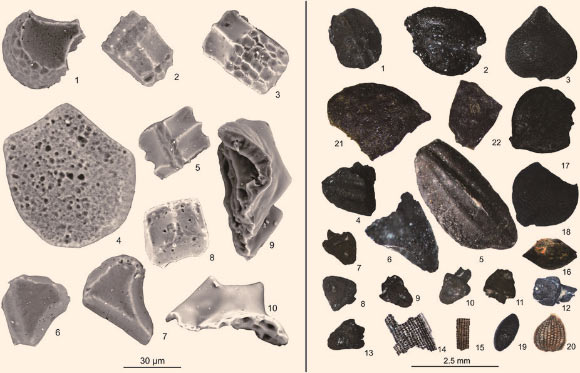The earliest evidence of domesticated rice (Oryza sativa), one of the world’s most important cereal grains, has been found in China, and it’s 9,000 years old.

Left: phytoliths from Poaceae bulliform cells and bi-peaked tubercles from rice husks recovered from Huxi: 1, 2, 3 – rice; 4 – reed; 5 – bamboo; 6, 7, 8 – silvergrass; 9, 10 – bi-peaked tubercles of rice. Right: charred plant remains from Huxi: 1 – self-heal; 2 – cupgrass; 3, 17 – sedge family; 4-6 – carbonized rice; 7-13 – rice rachillae; 14-15 – rice husks fragments; 16 – knotweed/smartweed; 18 – bristlegrass; 19 – crabgrass; 20 – tall fringe-rush; 21, 22 – foxnut. Image credit: Y. Zheng et al.
The discovery, announced in the journal Scientific Reports, was made by an international team of archaeologists led by Dr. Yunfei Zheng from the Zhejiang Provincial Institute of Cultural Relics and Archaeology in Hangzhou, China.
“Today, rice is one of most important grains in the world’s economy, yet at one time, it was a wild plant… how did people bring rice into their world?” said team member Prof. Gary Crawford, from the University of Toronto Mississauga, Canada.
The scientists found 9,000-year-old domesticated rice fragments at the Shangshan culture Huxi site, an open-air archaeological site in Yongkang County, Zhejiang Province.
They also unearthed artifacts such as sophisticated pottery and stone tools, as well as animal bones, charcoal and other plant seeds.
They observed that about 30% of the rice plant material – primarily bases, husks and leaf epidermis – were not wild, but showed signs of being purposely cultivated to produce rice plants that were durable and suitable for human consumption.
“The rice spikelet bases from Huxi include wild (shattering), intermediate, and domesticated (non-shattering) forms,” Dr. Zheng and co-authors said.
“The relative frequency of intermediate and non-shattering spikelet bases indicates that selection for, at the very least, non-shattering rice was underway at Huxi.”
This finding indicates that the domestication of rice has been going on for much longer than originally thought.
The rice plant remains from Huxi also have characteristics of japonica rice (Oryza sativa subsp. japonica), the short grain rice used in sushi that today is cultivated in Japan and Korea.
“This finding clarifies the lineage of this specific rice crop, and confirms for the first time that it grew in this region of China,” Prof. Crawford said.
_____
Y. Zheng et al. 2016. Rice Domestication Revealed by Reduced Shattering of Archaeological rice from the Lower Yangtze valley. Sci. Rep. 6, 28136; doi: 10.1038/srep28136







